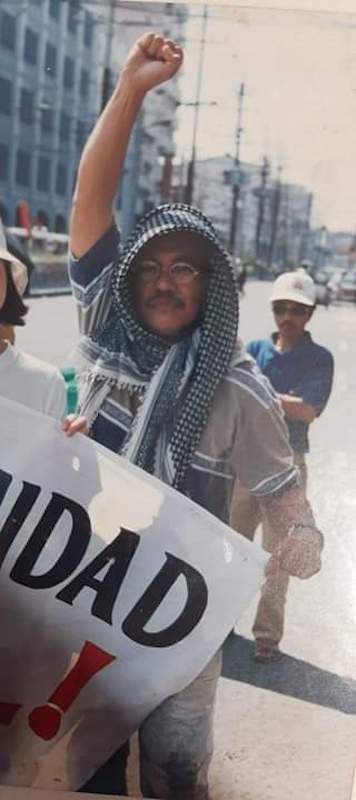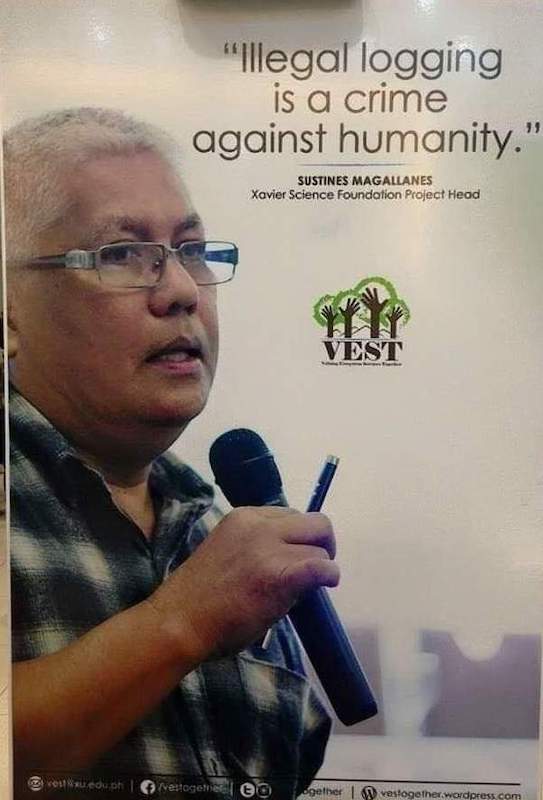CAGAYAN DE ORO CITY (MindaNews / 02 May) — Friends, loved ones, confreres have come to grips with reality upon hearing the demise of Sustines “Lolong” Magallanes last Friday.
A valiant environmentalist and exemplary development worker, Longskie to close friends, left behind 30 years of service to the community and the environment.
An agriculturist educated at Xavier University, Longskie worked as a pesticide salesman in the 1980s, until industrial pollution hit home in barangay Tablon in 1990. He organized the Lihok Katawhan Batok Polusyon (LKBP) to protest the pollution coming from the Cagayan Corn Products, Inc. (CCPI)., a corn starch factory.
The LKBP also exposed dumping of untreated waste from the Nestle plant in the same barangay.
 Lolong Magallanes speaks at a rally at the Department of Agrarian Reform in Quezon City in early 1997 for the distribution of the Carpo-Rufino Estate in Valencia City, Bukidnon. CONTRIBUTED PHOTO
Lolong Magallanes speaks at a rally at the Department of Agrarian Reform in Quezon City in early 1997 for the distribution of the Carpo-Rufino Estate in Valencia City, Bukidnon. CONTRIBUTED PHOTO
Later he teamed up with Orlando R. Ravanera, executive director of the NGO Centre for Alternative Rural Technology, Inc. (CART) who was organizing the environmental watchdog Task Force Macajalar (TFM).
Life then was organizing farmers and fisherfolk for sustainable livelihood and environmental rehabilitation by day and going after illegal logging, illegal fishing and industrial pollution at night.
As a result of the advocacies of the LKBP and TFM, the Department. of Environment and Natural Resources (DENR) became strict in requiring industrial plants to have waste treatment facilities. Among those compelled were the Del Monte cannery in Bugo, Nestle plant in Tablon and the CCPC also in Tablon.
Even with the installation of the waste treatment plants by the industries, it was still a cat-and-mouse game as the waters of Umalag River would sometimes smell coffee and the air in Tablon smelled rotten egg.
There was a time Tablon was called Barangay Baho. And each time this happens DENR technicians are called to do water sampling. If they failed to respond, it is war or they better prepare come Earth Day as their compound in Barangay Macabalan would surely be barricaded.
In 1993, responding to the calls of then Father Leds of Xavier University (Archbishop Antonio Ledesma), the TFM made its first Awit Barikada Kontra Logging at the highway fronting the Mannresa complex of the university.
It was three tense-filled nights as farmers, fisherfolk, students and NGO workers threw their bodies on the path of logging trucks. At one time, a truck hurdled past the barricades, the Bombo Patrol with the late Bombo Martirez gave chase, it overshot the curve near Pryce Plaza, the security guard of Bombo heroically pumped his shotgun on the wheels of logging truck, recalled lawyer Ed Cuaresma, current president of the Integrated Bar of the Philpipines Misamis Oriental chapter in his Facebook post honoring Magallanes. Cuaresma was then a college student.
Longskie, by then was the secretary general of TFM and a program officer at CART. “We did not have salaries as anti-logging barricaders and deputized environment officers, we have to earn our bread as community organizers, project managers implementing livelihood projects in upland and coastal communities” said Renante “Stan” Salcedo, who documented this work in his book The Field Worker published by Amazon in 2019.
As a result of the first anti-logging barricade, the Timber License Agreements (TLA) of Vicmar Devt. Corporation and Timber Industries of the Philippines, Inc. (TIPI) were no longer renewed by the DENR.
The anti-logging struggle became protracted when Vicmar and TIPI resumed large scale logging in 1996, with permits like Industrial Forest Management Agreement (IFMA), this time from the DENR-ARMM (Autonomous Region in Muslim Mindanao).
This time, the rape of the Cagayan de Oro and Lake Lanao watershed was massive with over 5,000 hectares of natural, dipterocarp forests razed to the ground purportedly for a palm oil plantation to be funded by an investment from Malaysia, a so called peace grant following the signing of the GRP-MNLF Peace Accord.
The logging barricades became intermittent until the year 2000 and spread to Wao in Lanao del Sur, in Maramag and Malaybalay City in Bukidnon.
The area razed supposedly for palm oil is now a mix of wasteland, vegetables and banana plantations at the lower slopes of the Kalatungan and Kitanglad mountain ranges.
 Lolong Magallanes, agriculturist, environmentalist. CONTRIBUTED PHOTO
Lolong Magallanes, agriculturist, environmentalist. CONTRIBUTED PHOTO
In all this, Longskie was in the heat of the battle, whether manning the barricades, running after illegal loggers, illegal fishers and industrial polluters. Longskie was an excellent mobilizer of people.
TFM’s core became a band of brothers. This included the likes of journalists Froilan Gallardo, Cong Corrales and Stephen Capillas, retired city environment officer Edwin Dael, retired air force serviceman Abel Idusma, mountaineer Geronimo Garcia, former DENR director Raoul Geollegue, lawyer Jong Dumlao, Salcedo and the brothers Ravanera – Orlando who is now chairman of the Cooperative Development Authority, Atty. Maning and Roel, vice president for social affairs of Xavier University. Of course the list cannot be complete without Msgr. Antonio Ledesma, SJ and staff of CART, a diverse group of community organizers and activists.
Among the dire warnings of TFM was an Ormoc-like disaster because of forest denudation and unsustainable farming in the watersheds of Cagayan de Oro and the Lanaos. It surreally came on Dec. 16 and 17, 2011.
Longskie had worked as senior community organizer for the Fisheries Resource Management Project (FRMP) from 2000 to 2005 in Butuan Bay. At this time TFM was campaigning against the Mindanao coal-fired power plant, warning about dire climate change impacts.
As a development worker for CART, he also managed sustainable agriculture projects in the uplands of Cagayan de Oro. He was also instrumental in organizing tenant farmers of the over 200-hectare Carpo-Rufino estate which was successfully distributed under agrarian reform despite threats of violence from the land owners in 1997.
In 2010, Longskie joined the Xavier Science Foundation, where he worked until his demise as Manager of the XU Lands Program.
At age 62, Longskie retained his good looks described by many as ruggedly handsome to millennials and baby boomers alike.
His positive demeanor — his shirt and tattered denims — did not show his struggles with cardiovascular disease for over five years and battle with prostate cancer.
Not a socmed adapter, he recently asked a friend to publish on Facebook his rant against the senseless cutting of trees for road widening projects.
He remained defiant against environmental destruction until his body could no longer take any beating 8 minutes past 8 o’clock of May 1, 2020. But his indomitable spirit lives on.
Longskie is survived by wife Delicia Barros-Magallanes, son Engr. Ken Magallanes and daughter Krishna Magallanes, a sophomore medical student. (BenCyrus G. Ellorin was spokesperson of the Task Force Macajalar and was a program officer of CART, Inc.).
